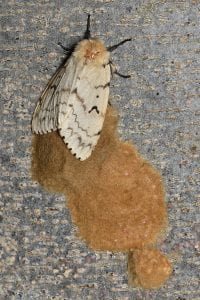Introduction
In Summer 2021 we saw a huge emergence of gypsy moth caterpillars. These voracious caterpillars emerged in June, parachuted into cropping fields from trees, and ate the leaves off of blueberries and strawberries with a great appetite.
The Latin name for these insects is Lymantria dispar, and that’s how they will be referred to throughout this blog post. While the term “gypsy moth” may be more familiar, entomologists are looking to rename the caterpillars to something that is not derogatory to Romani people. Translated from Latin, Lymantria means “destroyer” and dispar means “unequal”. It’s easy to understand why these caterpillars are called destroyers, and they are “unequal” because you can tell apart male and female caterpillars by appearance when they are about to turn into cocoons.
The 2021 generation of Lymantria dispar was record-setting. The warm, dry weather in May helped caterpillars emerge safely– in wetter years, a fungus (Entomophaga maimaiga) will infect young caterpillars and kill many of them off.
Lymantria dispar has one generation a year. Once caterpillars turn into moths, the moths will mate and lay eggs on trees. The next year, the cycle will begin again. We have our fingers crossed that the weather next spring will be wetter.
How to kill egg masses
If your farm has any trees on its property, you can take a couple hours this winter to kill off some Lymantria dispar eggs. Consider doing this if you are located in Clinton, Warren, Saratoga, Monroe, Livingston, Ontario, Seneca, Yates, or Orleans county. Populations were especially high in these areas.
Examine trees on your property, looking for orange-buff masses 1 – 3+ inches long. Look for masses without exit holes, old masses will persist for years but have holes, empty eggs, and fade in color over time. Check out other surfaces like firewood, dead trees, and leaf litter for these masses too.

These masses can be sprayed with horticultural oil between October – November and between April – May. Any time of year, they can be scraped off of the tree and dumped into a bucket of soapy water. It’s best to expose the eggs to some sort of chemical, like soap or a suffocating horticultural oil, to make sure they don’t survive.
Here is a YouTube video showing how to scrape off these egg masses from a tree.
How to prepare for next year
Another way to prepare for Lymantria dispar populations in spring is to make sure you have the appropriate chemicals to control them. Spraying young caterpillars is the most effective way to kill them, as they age they become less susceptible to pesticides. We recommend Bt pesticides for their specificity and efficacy.
Bacillus thuringiensis, or Bt (trade name DiPel) is an organic pesticide that is highly recommended for Lymantria dispar control. This is because it has no impact on humans, aquatic life, or bees. It has a 4-hour re-rentry interval and a 0-day pre-harvest interval. If you are purchasing DiPel forcontrol, keep this in mind:
- Ensure that the DiPel that you have lists either “Bacillus thuringiensis subspecies kurstaki” (BtK), or “Bacillus thuringiensis subspecies aizawai” (Bt aizawai) as the active ingredient.
You can also use the USA Pest Networks’ Pest Forecasting Tool to track populations of Lymantria dispar, as well as other pests.
References and further reading
Field Protocol for Sampling Gypsy Moth Egg Masses | NYS DEC
Gypsy Moth | NYS DEC
A Virus and a Fungal Disease Cause Lymantria Dispar Outbreaks to Collapse | Michigan State University IPM
Gypsy Moth Damage in Blueberry | Berry Diagnostic Tool
People are Talking about Gypsy Moths | Cornell IPM

